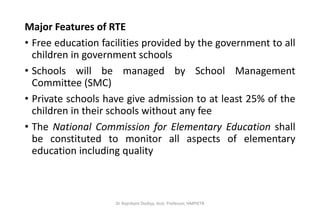Understanding RTE-Right to Education.pptx
- 1. “I don’t mind if I have to sit on the floor at school. I want an education and I am afraid of no one. Education is the power terrorists fear the most.” Dr Rajnikant Dodiya, Asst. Professor, HMPIETR
- 2. “Education…is the key to unlocking other human rights.” “Every child has a right to education as much as to life.” “Education is not a luxury, it is a basic human right.” “Education is a fundamental human right and essential for exercise of all other human rights.” “Education is not a privilege, it is a right.” Dr Rajnikant Dodiya, Asst. Professor, HMPIETR
- 3. BEd English Sem-I Unit-3 Understanding of Right to Education (RTE) Act, 2009 Dr Rajnikant Dodiya MA MEd PhD NET(Edu.&Eng.) GSET(Edu.&Eng.) Assistant Professor H M Patel Institute of English Training and Research, Vallabh Vidyanagar Mo.9638716634 E-Mail: [email protected] “Children are the one third of our population and the whole part of our future.”
- 4. This presentation is a collection and compilation of resource materials of RTE Act, 2009 for BEd (English) Semester-1 Trainees for their introductory understanding of the concept of RTE. Here, only necessary outline of RTE for BEd trainees is presented and not the whole document is explained. This author doesn't claim ownership to any of these materials except the ones the writer has created. Dr Rajnikant Dodiya, Asst. Professor, HMPIETR
- 5. Right to Education Act, 2009 Full Form of RTE is – Right of Children to Free and Compulsory Education Act; also known as Right to Education • This act was enacted by the Parliament of India on 4 August, 2009 • It tells that every child between the ages of 6 to 14 years has the right to free and compulsory education (Std.1 to 8) • It is stated as per the 86th Constitutional Amendment Act via Article 21A • By doing this, India became one of 135 countries to make education a fundamental right of every child when the Act came into force on 1 April 2010 Dr Rajnikant Dodiya, Asst. Professor, HMPIETR
- 6. • Act contains total 7 (Seven) Chapters with 38 Items • These 38 Items are divided in these seven different chapters • Chapter-1 Preliminary • Chapter-2 Right to Free and Compulsory Education • Chapter-3 Duties of Appropriate Government, Local Authority and Parents • Chapter-4 Responsibility of Schools and Teachers • Chapter-5 Curriculum and Completion of Elementary Education • Chapter-6 Protection of Right of Children • Chapter-7 Miscellaneous Dr Rajnikant Dodiya, Asst. Professor, HMPIETR
- 7. Major Features of RTE • Free education facilities provided by the government to all children in government schools • Schools will be managed by School Management Committee (SMC) • Private schools have give admission to at least 25% of the children in their schools without any fee • The National Commission for Elementary Education shall be constituted to monitor all aspects of elementary education including quality Dr Rajnikant Dodiya, Asst. Professor, HMPIETR
- 8. • Free and compulsory education to all children of India in the 6 to 14 age group. • A school within 1 km walking distance for children in classes 1 to 5; and within 3 kms for those in classes 6 to 8 • For remote areas where distance is longer than the prescribed limit, transportation facility shall be provided • No child shall be held back, expelled or required to pass a board examination until the completion of elementary education. • Twenty-five per cent reservation for economically disadvantaged communities in admission to Class I in all private schools is to be done. • No child is liable to pay any kind of fee or charges or expenses which may prevent him or her from pursuing and completing the elementary education. Dr Rajnikant Dodiya, Asst. Professor, HMPIETR
- 9. • If a child above six years of age has not been admitted in any school or admitted and could not complete his or her elementary education, then, he or she shall be admitted in a class appropriate to his or her age. • Further, if a child is directly admitted in a class appropriate to his or her age, he or she shall have a right to receive special training within a prescribed time limit. • He or she shall be entitled to free education till completion of elementary education even after fourteen years. Dr Rajnikant Dodiya, Asst. Professor, HMPIETR
- 10. • If any capitation fee is received by any school, there is fine ten times the fee charged • If any screening procedure is done by any school, there is fine of twenty-five thousand rupees for the first time and fifty thousand rupees for each next time • Birth Certificate is mandatory for admission but if it is not available with parents, admission can be given without it • No child admitted in a school shall be held back in any class or expelled from school till the completion of elementary education • No physical punishment or mental harassment (Item no.17) is allowed on the part of the teacher Dr Rajnikant Dodiya, Asst. Professor, HMPIETR
- 11. • SMC – School Management Committee shall be made that include parents or guardians and teachers • Total members in SMC shall be 12 (twelve) – including 9 members from parents or guardian • From the total number of members 50% should be female members • Duty of SMC is to control school activities, recommend school development plan and control the use of grant Dr Rajnikant Dodiya, Asst. Professor, HMPIETR
- 12. References • https://rotaryteach.org/Summary%20of%20RTE%20Act.p df Dr Rajnikant Dodiya, Asst. Professor, HMPIETR












